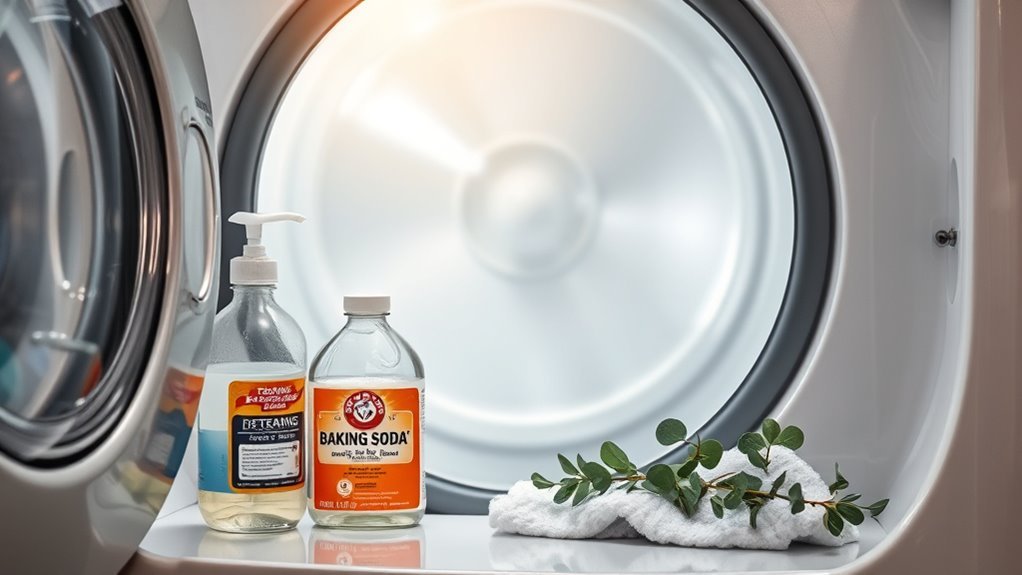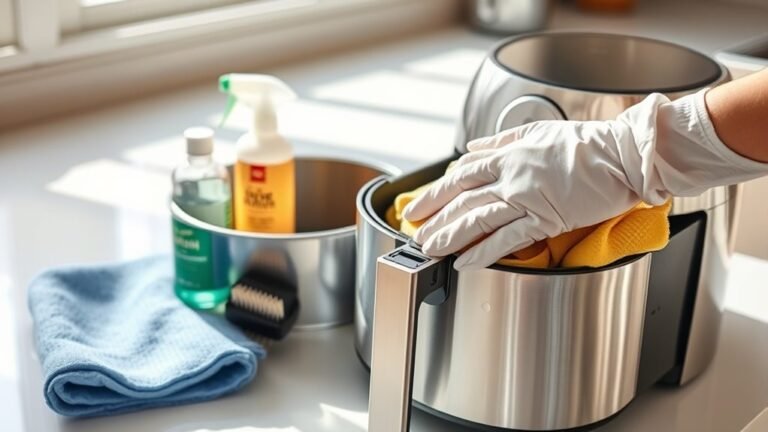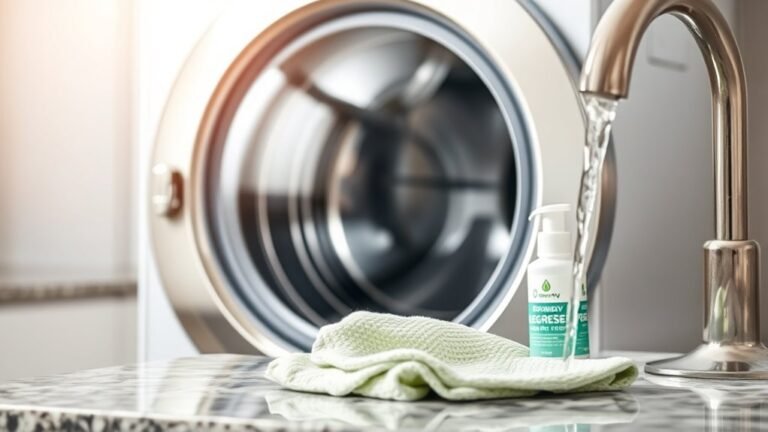How to Clean and Deodorize Your Washer
To clean and deodorize your washer, start by unplugging it and removing any visible debris from the drum, seals, and detergent dispensers. Pour two cups of white vinegar into the detergent compartment and run a hot water cycle to dissolve residues. Then add half a cup of baking soda directly into the drum and run another hot cycle to neutralize odors. Wipe the drum and rubber gasket with a vinegar solution and dry thoroughly. Follow these steps regularly to maintain freshness—there’s more detail on keeping your washer pristine ahead.
Identifying Common Causes of Washer Odors

Although washers are designed to stay clean, odors can develop over time due to moisture buildup, detergent residue, and trapped debris. You must recognize that a damp environment inside the washer drum creates ideal conditions for mold growth. This mold often accumulates around the rubber door seal and detergent dispensers, where moisture lingers. Additionally, leftover detergent and fabric softener residues can trap dirt and bacteria, further contributing to unpleasant smells. It’s essential to understand that these odors are symptoms of underlying issues: inadequate drying and insufficient cleaning cycles. By identifying these common causes, you take the first step toward reclaiming your washer’s freshness and ensuring it operates without foul odors, granting you the freedom to do laundry confidently and hygienically.
Preparing Your Washer for Cleaning
Before you begin cleaning your washer, gather all necessary supplies and make certain the machine is empty. Start by unplugging the washer to guarantee safety during your maintenance process. Remove any visible debris from the drum and detergent dispensers. Next, inspect rubber seals and the door gasket for mold or residue buildup; these areas require attention during washer maintenance. Have your cleaning supplies ready—this includes gloves, microfiber cloths, and appropriate cleaning agents designed for washers. Confirm you have access to clean water for rinsing. Preparing your washer thoroughly allows you to address all internal and external components effectively, preventing odors and prolonging the machine’s lifespan. This disciplined preparation step sets the foundation for efficient, freedom-driven washer upkeep.
Using Vinegar and Baking Soda to Remove Residue

Two common household items, vinegar and baking soda, form an effective combination for breaking down residue inside your washer. Vinegar benefits include dissolving mineral deposits and neutralizing odors, while baking soda effectiveness lies in its gentle abrasive quality and ability to balance pH levels. To use them properly:
- Pour 2 cups of white vinegar into the detergent dispenser or drum.
- Run a hot water cycle to allow vinegar to loosen soap scum and residues.
- Add 1/2 cup of baking soda directly into the drum and run another hot cycle to scrub and deodorize.
This method guarantees thorough residue removal without harsh chemicals, freeing your washer from buildup and maintaining peak performance.
Cleaning the Washer Drum and Seals
The washer drum and seals are critical areas where dirt, detergent residue, and moisture accumulate, leading to mold and unpleasant odors if left uncleaned. For effective drum maintenance, start by wiping the drum interior with a microfiber cloth dampened in a solution of equal parts water and white vinegar. Pay close attention to the drum’s perforations, as trapped debris can cause odors and damage. Seal care requires you to gently pull back the rubber gasket and remove any visible grime or lint. Use a soft brush dipped in the vinegar solution to scrub the folds and crevices thoroughly. After cleaning, dry both the drum and seals completely to prevent moisture buildup. Regularly addressing these components guarantees your washer runs efficiently while preserving your freedom from persistent odors.
Maintaining Freshness With Regular Washer Care

Once you’ve thoroughly cleaned the drum and seals, maintaining your washer’s freshness requires consistent care. To guarantee peak washer hygiene and prevent mildew buildup, integrate these practices into your routine:
- Leave the door open after each cycle to promote air circulation and moisture evaporation.
- Regularly run an empty hot water cycle with a washing machine cleaner or white vinegar to disinfect and break down residues.
- Wipe down the gasket, detergent dispensers, and drum interior weekly to remove lingering dirt and moisture.
Frequently Asked Questions
Can I Use Bleach Instead of Vinegar for Cleaning My Washer?
You can use bleach for washer maintenance, as it has strong disinfecting and stain-removing properties, making it quite effective for cleaning. However, bleach can be harsh on some washer components and may cause wear over time. Vinegar is gentler but less potent. To balance bleach effectiveness and machine longevity, use diluted bleach in a maintenance cycle, avoiding mixing with other cleaners. Always follow your washer’s manual for safe, effective cleaning.
How Often Should I Replace My Washer’S Water Filter?
You should check your washer’s water filter lifespan regularly, monitor for filter replacement signs like reduced water flow or unusual noises, and replace the filter accordingly—typically every 6 to 12 months. Ignoring these signs can reduce efficiency and damage your machine. By staying attentive to your filter’s condition, you guarantee peak performance, prolong your washer’s life, and maintain freedom from unexpected breakdowns or costly repairs.
Will Cleaning the Washer Help With Mold Allergies?
Yes, cleaning your washer regularly plays an essential role in mold prevention, which directly contributes to allergy relief. Mold thrives in damp environments like washers, so by removing residues and moisture buildup, you reduce mold growth. This minimizes airborne mold spores that trigger allergies. To guarantee effective mold prevention, clean your washer’s drum, seals, and detergent dispensers using appropriate cleaning agents and run maintenance cycles frequently. This proactive approach enhances your living freedom by improving air quality.
Can Washing Machines Damage Certain Types of Clothing?
Ever wondered if your washing machine could actually harm your clothes? Yes, it can, especially with delicate fabrics like silk or lace, which might get snagged or stretched. Also, frequent washing, especially in hot water, can cause color fading on vibrant garments. To protect your wardrobe freedom, always check care labels, use gentle cycles, and opt for cold water when possible. This way, you keep your clothes looking fresh without damage.
Is It Safe to Run a Washer Cleaning Cycle Without Laundry?
Yes, it’s safe to run a washer cleaning cycle without laundry. In fact, for ideal washer maintenance, you should perform this cycle regularly—typically once a month. This cleaning frequency helps prevent residue buildup, odors, and mold. Running the cycle empty allows detergent or specialized cleaner to thoroughly sanitize the drum and internal components, ensuring your washer stays efficient and your clothes remain fresh every wash.






